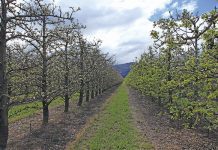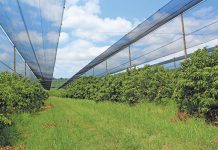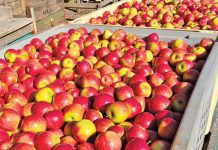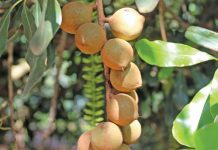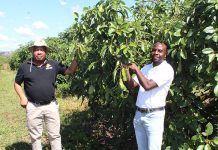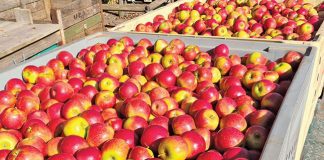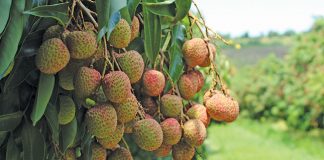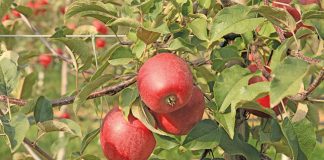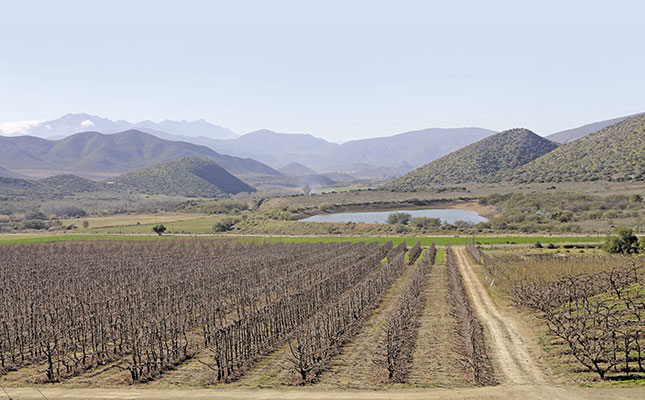
Photo: Denene Erasmus
When Hannes Toua accepted his Western Cape Young Farmer of the Year Award earlier this year, he said that farming could best be described by comparing it to a long marriage. “Even when things get tough you hang in there because of love. I became a farmer because of my love for farming and despite the challenges we face I still love what I do.”And while Hannes’s enthusiasm for his own farming operation serves as evidence of his love of this job, the success he has achieved in a relatively short of time shows that he is also driven by a keen sense of business and as such is an expert in the challenges facing SA fruit farmers.
READ: Pomegranates power ahead
Current challenges facing SA fruit farmers
Cerasus Boerdery
Hannes grew up on a sheep farm in the Karoo near Williston, but after studying at the Worcester College of Agriculture he turned his attention to fruit farming.
Today he is a shareholder and manager of Cerasus Boerdery in the Hoeko Valley outside Ladismith in the Klein Karoo. The farm consists of 46ha fruit plantings under irrigation and production is divided as follows: 24,5ha to plums, 12,5ha to apricots, 3ha to peaches and 7ha to pomegranates.
The business was set up in 2006 when Johan Furstenberg bought the land. Hannes joined in March 2008 as the manager. More recently, he was appointed as one of three directors of the enterprise. “I manage the day-to-day business on the farm,” he explains. “Most of the fruit we produce is exported, 60% to 70% of this to the UK and the EU. A small percentage of our product is marketed locally.”

Hannes Toua
Hannes manages 21 permanent farm workers. During the harvest, up to 140 seasonal labourers are brought in to help pick and pack the fruit. All the fruit produced by Cerasus Boerdery is packaged in the on-farm packhouse facilities.
Hannes’s wife, Marietjie, helps by handling many of the administrative duties on the farm and looking after their happy toddler, Gideon, who, wisely, spends most of his time eating, sleeping and playing.
Production notes
All the fruit planted on the farm is under irrigation; the fruit orchards have micro-irrigation or drip-irrigation systems through which fertilisers are applied as well. Irrigation scheduling is implemented with DFM continuous logging probes – multilevel soil water and temperature logging devices.
“We don’t apply a fixed volume of water, but irrigate according to the needs of the plant and the soil,” Hannes explains. “The orchards are irrigated year-round, but we cut back on water during winter.
“We’re still learning the tricks of farming with pomegranates and our orchards are very young,,” he says about the challenges facing SA fruit farmers. The yield is now about 12t/ha to 15t/ ha, but when the trees come into full production we hope to harvest 30t/ha or more.”
Since taking over the farm in 2006, the business owners have invested in planting 26ha of new orchards between 2008 and 2010. Some of these are not yet in full production, but according to Hannes, about 50t/ ha of peaches, 20t/ha to 45t/ ha of plums (depending on the cultivar) and 20t/ha of apricots are presently harvested.
Hannes hopes to add another 20ha of orchards and maintain an orchard replacement rate of between 10% and 15% per year. Compost is made on the farm using a mixture of pinewood chips, cattle manure and hay that is spread out in windrows, then left for up to a year to decompose.
“When the compost is ready, we put it in 12,5l heaps between trees in the orchards,” explains Hannes. “If we spread it out too thinly, the beneficial nutrients and organisms in the compost get burnt by the sun. By placing the compost in heaps, we encourage fine roots from the fruit trees to grow into the heap and extract nutrients from the compost.
“Our aim with the fertiliser programme, designed by Microbial Solutions, and the irrigation scheduling and compost application, is to create a balanced, beneficial environment for the trees, where they have access to micro-nutrients to produce good quality, high yields on a sustained basis.”
Pruning and pest control
The trees are pruned twice a year, once in winter and again in summer. In winter, the pruning is aimed at improving and maintaining the frame of the tree. In summer, unnecessary leaves and branches are removed to manage light distribution in the trees and among the fruit. To ensure quality, fruit is manually thinned once or twice during the fruiting season, depending on how heavy the fruit set is.
“We always leave more fruit on the trees than we will need to harvest,” says Hannes. “This is just one of the ways in which we manage risk. The area suffers heavy hailstorms, so we need to leave some extra fruit on the trees in case a percentage of the crop suffers hail damage.”
The main pests that occur in the area are false coddling moth, fruit fly and thrips; these are controlled on a preventative basis by implementing a regular pest control plan.Hannes’s integrated pest control programme also includes the use of mating disruption technology and micro-organisms that feed on some of the pests.
One of the pests that can cause large-scale devastation, if not controlled, is the fruit piercing moth (suigmot), which is almost impossible to control through chemical intervention. These nocturnal moths migrate from the Eastern Cape to the Western Cape in summer. Floodlights have been installed in the orchards to disrupt the moths’ activity by simulating daylight conditions at night.
Vision, labour and marketing
Commenting on the challenges facing SA fruit farmers, Hannes says the biggest challenge in agriculture is to maintain a clear vision when facing problems and to see the opportunities in situations. “Be positive and consult experts who can give you advice on the best options for your business,” he stresses.
He believes that the current labour situation, particularly the high cost of labour, is another major challenge for farmers.
“We farm labour- intensive crops and wages make up 40% of our total costs. To ensure the financial sustainability of a business, we need to look at mechanisation options that will allow us to implement new technology to make the farm more profitable,” he says.
However, Hannes also believes that farm worker expertise levels will need to take a big step forward, with workers acquiring specialist skill sets. “Farm workers will have to become highly productive to justify the high cost of labour,” he says.
The third big challenge to keeping any farming business viable in the short term is effective cash flow management, explains Hannes. “It’s critical that farmers become more knowledgeable about their industry and the market dynamics of that industry,” he says.
He himself is exploring new, non-traditional export markets for their fruit. “There’s an oversupply in the UK and EU of the fruit we produce at the time we deliver to those markets. For our business to remain profitable, we must look at new markets.
However, our product requires advanced cold chain infrastructure, so it’s not always possible to enter emerging markets. Nonetheless, we’re exploring options in Africa, Asia and other parts of Europe, such as Russia,” he explains.
Perseverance
Hannes is a respected community leader and plays an active role in organised agriculture. He is the chairperson of Agri Ladismith, a managing member of Agri Klein-Karoo and the Eden district’s representative on Agri Western Cape’s Young Farmer Committee.
These are difficult times for farmers, he says, but at the same time he believes there is a bright future for those who are willing to work hard and put effort into making the right decisions.
“I think we just have to have the guts to hang in there for five more years,” he emphasises. Hannes points out that South African farmers are experiencing a time of great change and uncertainty.
To add to this, with regard to the challenges facing SA fruit farmers, he says they have little control over what is happening in the sector and the country at the moment. He does not think this situation will last, however.
“Focus on the things you can control in the meantime,” he advises. “Build good, solid relationships with your trade partners. Produce the best quality product that you possibly can, and use the available technology and research to your benefit.”
Contact Hannes Toua on 028 561 1635 or email [email protected]
This article was originally published in the 2 August 2013 issue of Farmer’s Weekly.


